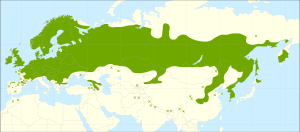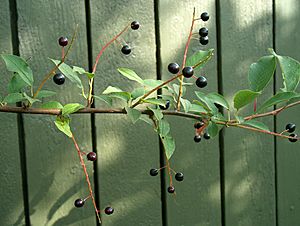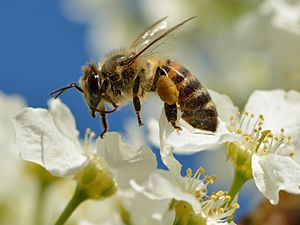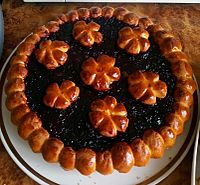Prunus padus facts for kids
Quick facts for kids Prunus padus |
|
|---|---|
 |
|
| Bird cherry flowers | |
| Conservation status | |
| Scientific classification | |
 |
|
| Distribution map | |
| Synonyms | |
|
List
|
Prunus padus, known as bird cherry, hackberry, hagberry, or Mayday tree, is a flowering plant in the rose family. It is a species of cherry, a deciduous small tree or large shrub up to 16 metres (52 ft) tall. It is the type species of the subgenus Padus, which have flowers in racemes. It is native to northern Europe and northern and northeast Asia, and is grown as an ornamental in North America.
Contents
Distribution
Prunus padus is native to eastern, central and northern Europe and spans central latitudes of Asia, including Japan. Its distribution includes the all of Western and Central Europe north of the Pyrenees and the Alps and south of the treeline with small pockets also found in Iberia and Northern Italy and even parts of North Africa. It also inhabits all of Eastern Europe north of the Balkan Mountains and the Steppe, as well as in the Caucasus. In Asia it is found throughout the forests of Siberia, the Russian Far East, Korea, Hokkaido, and parts of China with pockets in the Himalayas.
The Mayday tree is abundant as an introduced species in Anchorage, Alaska, having been planted in great numbers by landscapers and homeowners.
Description
The fruit is astringent due to its tannin content.
There are two varieties:
- European bird cherry Prunus padus var. padus, Europe and western Asia.
- Asian bird cherry Prunus padus var. commutata, eastern Asia.
Ecology

The flowers are hermaphroditic and pollinated by bees and flies. The fruit is readily eaten by birds, which do not taste astringency as unpleasant.
In Eurasia, the Bird-cherry ermine moth (Yponomeuta evonymella) uses bird-cherry as its host plant, and the larvae can eat single trees leafless.
In North America the tree is often attacked by the black knot fungus.
Poison
The glycosides prulaurasin and amygdalin, which can be poisonous to some mammals, are present in some parts of P. padus, including the leaves, stems and fruits.
Uses
The fruit of this tree is seldom used in western Europe, but, long ago, may possibly have been used as a staple food far to the east. According to Herodotus (writing some 2500 years ago) a strange race called the Argippaeans, all bald from birth, who lived in an area identifiable possibly as the foothills of the Urals, would pick the bean-sized fruits of a tree called "pontic" and squeeze from them a drinkable black juice, making afterwards, from the residue of the pressing, a type of cake. This juice and the "cakes" produced in its manufacture were, according to Herodotus (who derived his account from the reports of Scythian traders), the main sustenance of the "bald people". Furthermore, according to A. D. Godley (translator of an edition of the works of Herodotus published in the early 1920s) it was said that the Cossacks not only made a similar juice from Prunus padus, but also called it by a name similar to the one (aschu) by which the bald Argippeans called theirs. As might well be expected of so cherry-loving a race, the Argippeans - a just and kindly people - took good care of their trees, protecting them from the harsh winters of their homeland - seemingly by incorporating them (as a central pole symbolising the axis mundi) into the yurt-like felt tents in which they lived:
They dwell each man under a tree, covering it in winter with a white felt cloth, but using no felt in summer. These people are wronged by no man, for they are said to be sacred; nor have they any weapon of war. These are they who judge in the quarrels between their neighbours; moreover, whatever banished man has taken refuge with them is wronged by none.
- Herodotus, Ἱστορίαι (The Histories) Book IV, Chapter 23
In Russia the fruit of the tree is still used for culinary purposes. The dried berries are milled into a flour of variable fineness that forms the principal ingredient of bird-cherry cake. The flour is brown, and so is the cake, even though there is no chocolate in it. Both flour and cake are sold in local stores and bakeries. In a more conventional method of preparation, fresh bird cherries may also be minced and cooked to make jam.
The variety commutata is sold as an ornamental tree in North America under the common name Mayday. It is valued for its hardiness and spring display of fragrant, white flowers. The common name Mayday tree refers to the May Day festival, being unrelated to the distress signal mayday. The name for the tree was in use prior to the adoption of "mayday" (the phonetic equivalent of the French m'aider - from venez m'aider, "come [and] help me") as an international distress signal.
A taboo on the use of the wood of the hackberry (or hagberry) was reported by natives of Advie, in northeast Scotland, who believed it to be a "witches tree".
The tree was used medicinally during the Middle Ages, during which period it was also believed that the bark of the tree, placed at the door, would ward off plague.
Culture
In Finland and Sweden, the blooming of bird cherry (Finnish tuomi) signifies the start of the summer for many people. In southern Finland, this normally takes place during the two last weeks of May or very early June.
See also
 In Spanish: Cerezo de racimos para niños
In Spanish: Cerezo de racimos para niños





